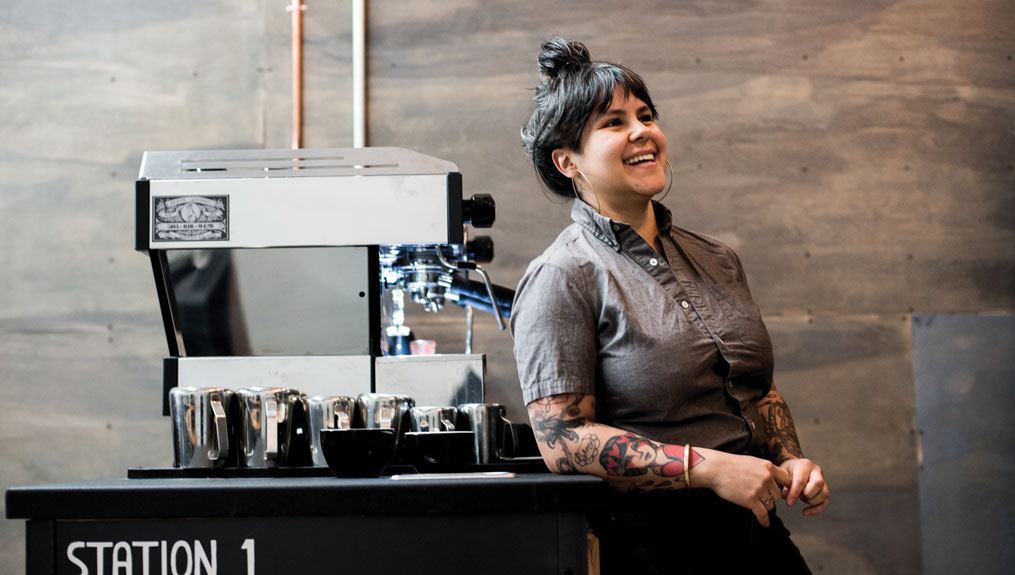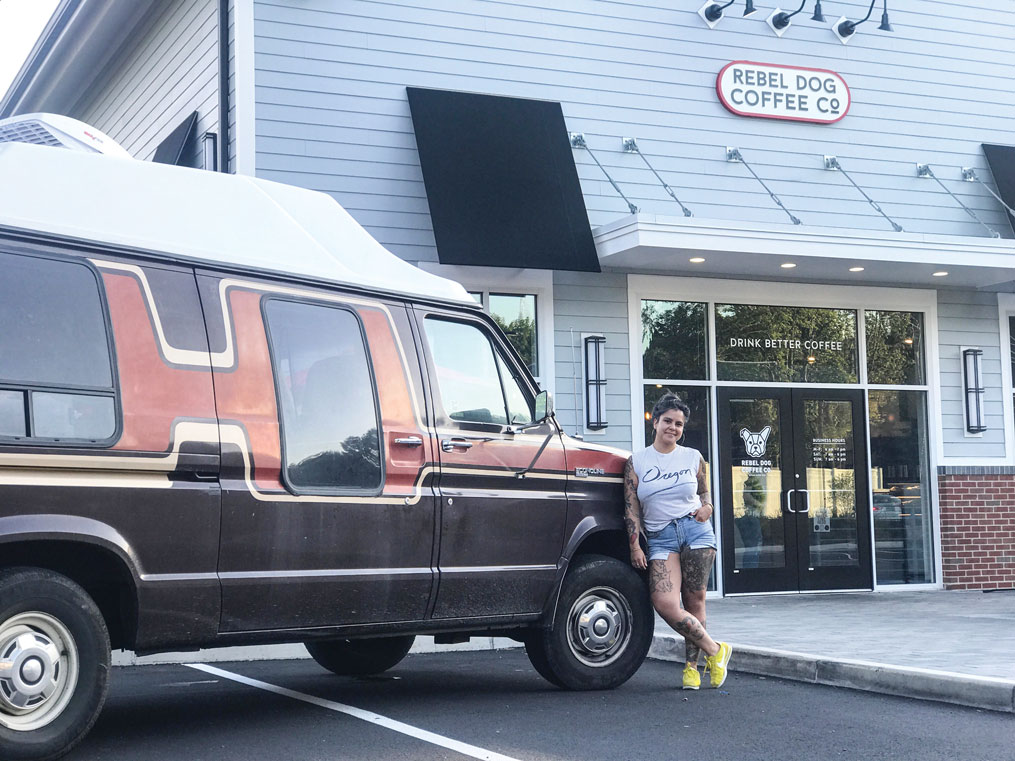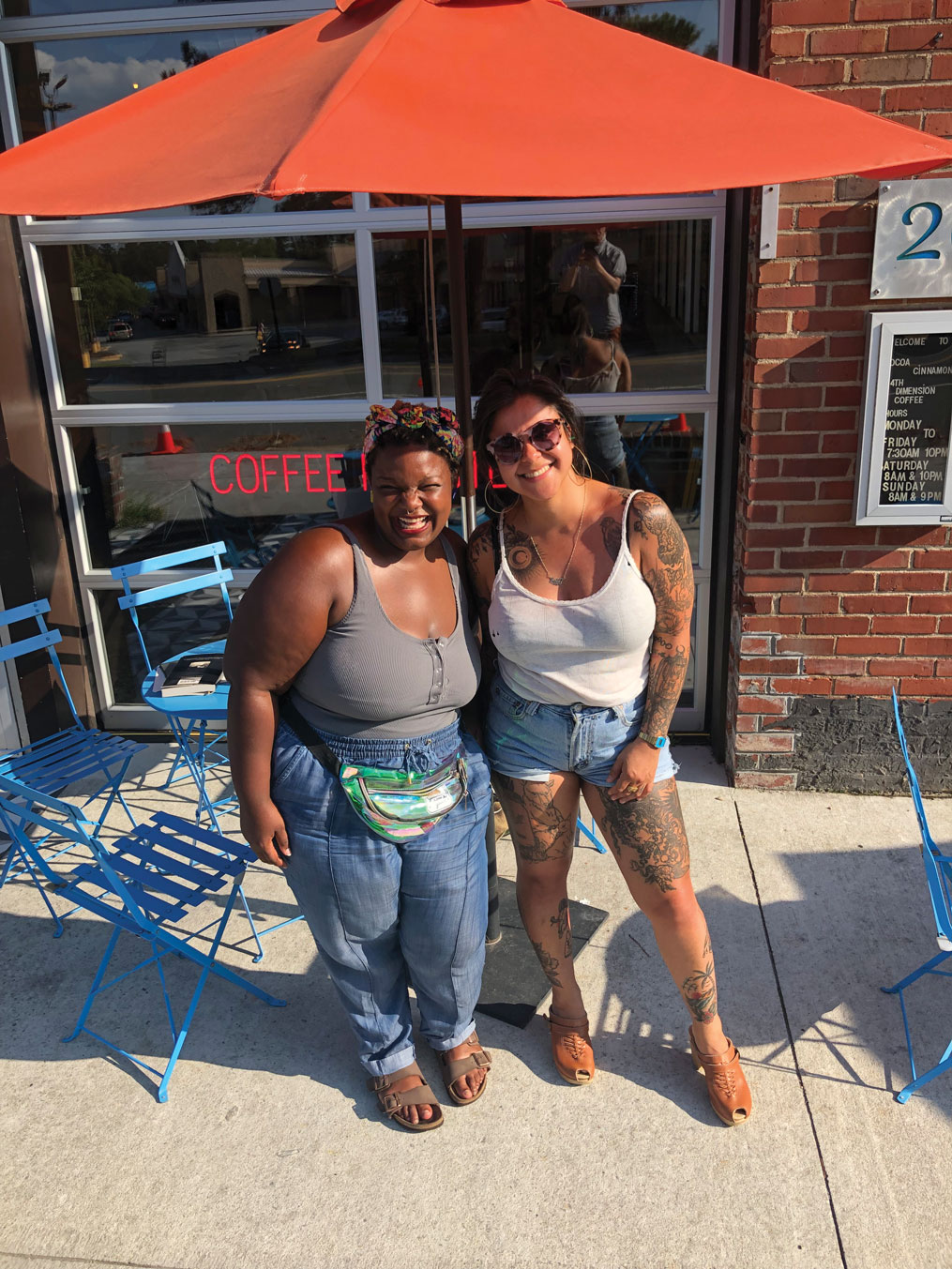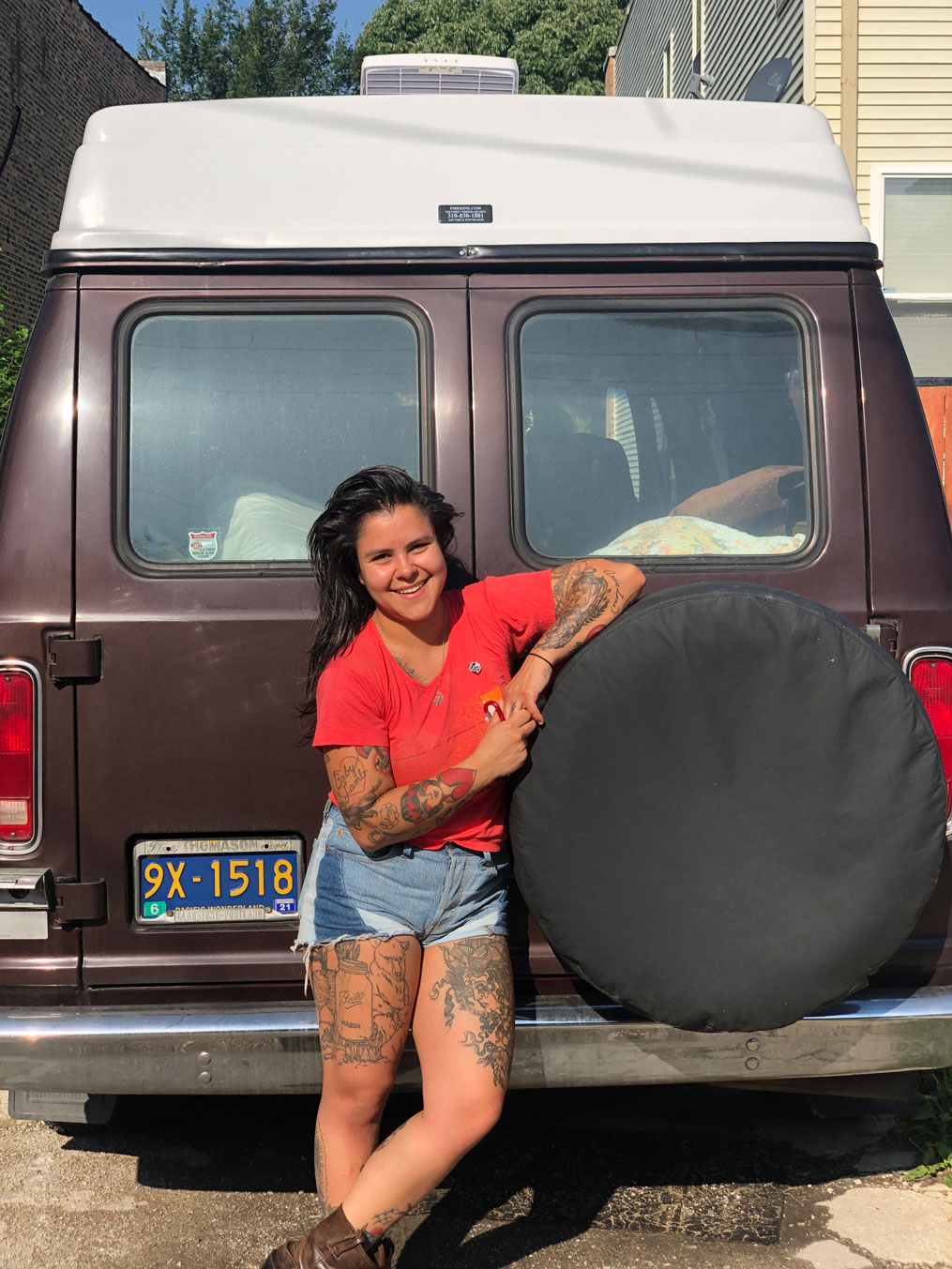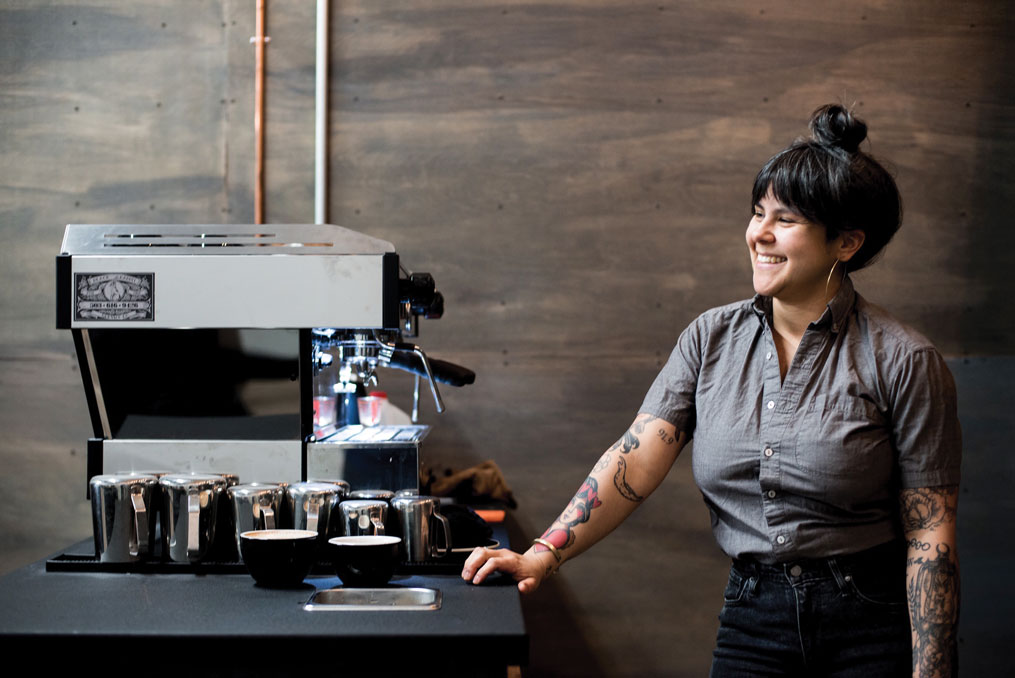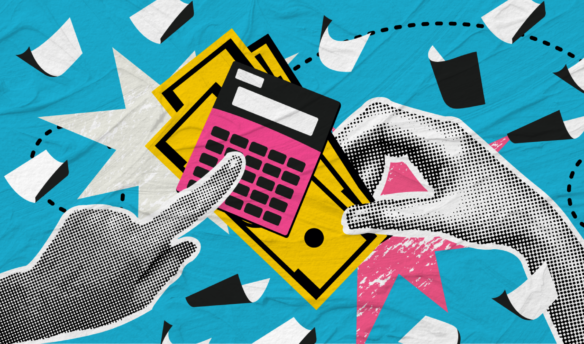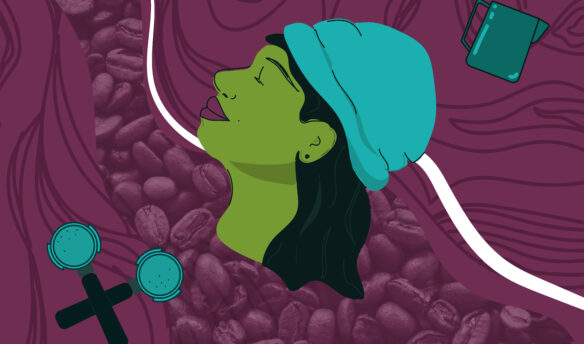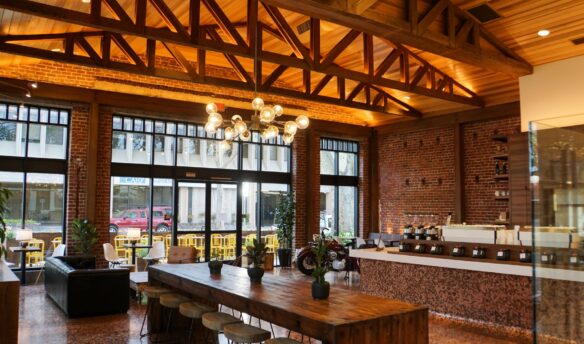Camila Coddou. Photo by Kale Chesney
[B]ack in June, longtime coffee professional Camila Coddou set out from Portland, Oregon, to travel the country and talk to baristas in order to answer the question: “How do we make the coffee industry a more equitable and supportive work environment, welcoming to all who share our passion?”
Since embarking on this project, Barista Behind the Bar, Coddou has spoken with baristas from Seattle, the Bay Area, Minneapolis, Chicago, Detroit, and other cities about topics ranging from hospitality and self-care to inclusivity and empowerment. She also regularly hosts discussions on Instagram, asking questions via Barista Behind the Bar stories, sharing responses from her followers, and adding her own insights. And in September, she launched a survey for coffee professionals to anonymously answer questions to better inform her work, the findings of which will be released in the coming months.
Coddou recently took the time to speak with Fresh Cup about her journey with Barista Behind the Bar.
Fresh Cup: Tell us a bit about the inspiration behind Barista Behind the Bar. What was the impetus behind this journey? What were your goals setting out?
Camila Coddou: The idea for Barista Behind the Bar came to me while I was taking a shower—it’s where I get all my best thinking done. I have worked in coffee for over ten years, and in those ten years I’ve had so many wild experiences. Some have been awesome, and some have left me feeling pretty down. Most of my work over that decade was in management. Somewhere in there I realized that my best work came from creating supportive environments in which baristas could thrive. This became my goal, and I did my best (messing up at times but always trying to do better) throughout my time in coffee to foster these spaces. Barista Behind the Bar is an extension of this passion. It’s not only creating space for baristas to share their stories and feel heard, it’s also highlighting the fact that our employees, most of whom make minimum wage, have so many amazing business ideas which hardly ever get heard. The goal of this project is to get conversations started, make sure baristas are feeling heard and having their ideas valued, and travel around the country meeting baristas and interviewing them. I just completed five weeks on the road interviewing baristas in the Midwest, Northeast, a bit in the South, and on the West Coast, and plan on heading out again in the next few months.
What was your preparation for your travels like? Did you reach out to baristas and cafés before hitting the road? Did you plan a detailed itinerary, or just see where each day would take you?
Travel prep revolved a lot around considerations for the van I was driving. It was important for me to have a space where I could sleep and cook, thereby keeping my travel costs down, and that I be able to navigate city streets and tight parking spots.
I bought a 1983 Ford conversion van for this, and although it might not have been the absolute best pick, it ticked a lot of the boxes. My partner, Lola, and I spent a lot of time ripping out carpet, installing fans, and insulating. It was a crash course in van conversions!
As for how I scheduled and planned, at the time of setting out, I had a pretty great amount of followership on Instagram. Most baristas who were interested in speaking reached out to me there and through the website submission form and I had been in communication with so many awesome baristas during the months of preparation. I decided that I wanted to cover certain areas/states, knowing that for this leg of the trip I wouldn’t get everywhere I wanted to go. So it was a mixture of both—I had a loose itinerary/idea of a region I would cover, and baristas in each area that had already been in touch, and would plan a few days in advance where I would go next within a certain region. I would post dates and locations a day or two in advance, and then baristas would get in touch to schedule a meeting. This allowed me to keep sessions with long-standing relationships, and invite in new followers who might be interested on the fly.
What are your favorite road trip snacks? Podcasts? Songs/artists to listen to?
I joked to Lola the other day that I want to make bumper stickers that say, “Ira Glass is my co-pilot.” So yeah, I listened to a ton of This American Life. I also listen to a lot of storytelling podcasts like The Moth and Risk. The van doesn’t have AC, so unfortunately, I had to have the windows down all day, which did make listening to podcasts a bit challenging, so this meant that Ira Glass was cranked all the way up. I also really love music, but sometimes making playlists can be a bit of a drag, so I relied heavily on the playlists Spotify creates for me. On heavy rotation when not listening to playlists: Blood Orange, Little Dragon, Broadcast.
But you know what I found really interesting? Driving for so many hours in a day (sometimes I would be in the van non-stop for basically 12 hours getting from one place to the next) eventually made me tired of hearing stuff. Many times I found myself actually turning everything off and just sitting with my thoughts in (relative) silence for hours at a time.
Snacks: tons of jerky, miso soup cups that just need hot water, lentil soup boxes, dried mango, popcorn, and lots of coconut water.
How do you practice self-care on the road?
My father passed away in January of this year, so for me, self-care has been extra important as of late and also taking on new and different iterations. Number one for me was to do my best to ease up on any sort of “agenda” or preconceived idea of what would make this trip/project “successful.” I didn’t always succeed at quieting those voices of doubt in my head, but I think reminding myself to be gentle and release control was a constant and daily practice. That helped keep me grounded and helped me bring my best to each interview.
‘Cause that’s the other thing—holding space can be very emotionally draining. It’s hard for the barista being interviewed to share challenges they’ve faced at work, and it’s also emotionally vulnerable to receive that information. Self-care was imperative.
Other things I do for self-care: weight lift and CrossFit. Physical activity helps me drop into my body, and CrossFit is a modality that really works for that. I went to gyms around the country and that was a fun way to explore cities. Reading a good book with a hot cup a tea is also something I did basically every single night in my van. It was a nice relaxing ritual.
How has the reception been from baristas? From café owners/managers? Do you notice a difference in how people perceive the project based on their position in the industry?
Even though there have been large stretches of this trip during which I didn’t see anyone I knew, everywhere I went and got to interview baristas felt like I was making a new friend, a new important connection. The opportunity I had to connect with so many passionate coffee professionals was so inspiring, and the reception has been so lovely—in both directions! This was true for management and ownership I met along the way as well.
I think most people perceive the idea behind the project as basically supportive, and most people, no matter what position they hold, do see the value in people feeling heard. I haven’t noticed much discrepancy there.
What have been some of the biggest lessons you’ve learned talking to baristas?
The biggest lesson I’ve learned is that literally everyone is so smart, caring, and has a specific thing they are passionate about and want to see improve. Initially I figured, okay, most people who want to speak with me will have similar ideas, concerns, and interests. But of course that is so not the case! I’ve learned so much about all the things coffee professionals are passionate about, and they’re as multifaceted as the coffee industry itself. Some people I spoke with were excited to talk about how important accessible education was to them. Some people touched on how to make cafés more supportive for employees, for customers, how to bring more support towards the challenges that farmers face, ways in which they engage in self-care. People are in this industry because they love coffee, or because they are looking for a specific kind of benefit, or because they were friends with a barista and were welcomed into the community.
After leaving my last employer, I took a long break from coffee and felt pretty done with the whole business. But what I have re-learned during this experience and through speaking with baristas, is that there is a reason I was in the industry for so long: because of the community we’ve been able to build.
Now we just need to put in the work to protect that community.
How have you had to adjust your plans or expectations of this project?
One of the first things I adjusted was my perception on how long things would take. To begin with, it takes me hours to transcribe a single one-hour interview. I had no idea transcribing took so long!
The second thing I had to adjust was how many interviews I could do in a day. I can tend to overwork myself, and initially I was scheduling four to five interviews a day, with only about 30 minutes in between each one. That was NOT enough time to process, recharge, and get ready for the next interview. Sitting with people in such vulnerable space was wonderful and cathartic, and could also be exhausting, so I set my limit at three interviews a day.
The fun thing is though, since I am doing this whole thing on my own, I can allow this project to evolve and change as naturally and as often as is needed. For instance, I initially thought I would do guest spots at cafés to try to entrench myself in the café culture of a specific place. But then I thought that might make it hard for baristas to talk to me if they had something negative to say about their work environments. I was the only person I had to check with when deciding to scratch that!
And lastly, I have had to readjust how long the actual travel portion takes. I feel like if there is one thing I really learned on this project is that I am no longer in my twenties and that driving 460 miles alone in one day is my personal limit! That didn’t used to feel so hard. But in any case, this just meant that I couldn’t cover as much ground as I had initially planned. But that’s okay, ‘cause the project is not over yet and I am in the planning stages of the next leg.
What was the idea behind the survey? How was the response?
The survey was actually an idea that my best friend, Tina, suggested. She works in public health and is a total data wizard. I told her that I was planning a presentation for The Barista Guild’s Access event, and she was like, wouldn’t it be cool to have some data points for that?! She helped me put it together, write it all out, and make it look professional. We put it up at midnight one week before my Access presentation, and by the following day we have over 200 responses. We couldn’t believe it! We are up to 700+ now, and this data has helped illustrate what sorts of support has been received and has been lacking for various groups of people across various ages, gender and race identities, and experience levels.
We will be analyzing the data soon, and I can’t wait to share the findings.
Your Instagram stories always include thought-provoking questions and provide wonderful, insightful dialogue from you and your followers. Why is it important to carry the conversation over into Instagram?
Instagram is a flawed platform, to be sure, but it’s free and widely available, and keeping things accessible is one of the main objectives of Barista Behind the Bar. I used my Instagram stories to share the entire contents of my Access presentation since entry to the event was over $400, a price I know most baristas couldn’t afford. That was a huge bonus of the platform, and one of the reasons I rely so heavily on it. I can share things quickly, for free, engage community members in a way that is instant and genuine, and it’s easy to save things, track engagement, and connect through DMs.
It’s also completely impossible for me to interview everyone who wants to participate in Barista Behind the Bar. Therefore, I use Instagram as a way to feature people I don’t get to meet in real life, and also give them the platform of the Barista Behind the Bar account.
The thing about Instagram that doesn’t work for me is that it limits visibility of content to those with access to a smart phone, and that is a huge barrier. One of my ultimate goals for BBB is to engage service industry professionals from all industries in conversations around labor rights and supportive work environments—not just coffee professionals. As the BBB community grows, the method of sharing information will also need to evolve and can’t keep people out along lines of access to technology.
What’s next for Barista Behind the Bar?
The biggest and coolest Barista Behind the Bar project I am working on now? An all-day coffee industry event that features workshops led by PoC, queers and femmes, and is free for baristas to attend, giving preference to those who are new to the industry. Stay tuned for details on that!
Anything else you’d like our readers to know?
Thanks to everyone following along. This work means so much to me, feels so important for our industry right now, and is so much fun. I also want to thank all the other amazing people in coffee right now making things happen, including but not limited to Ashley [Rodriguez] of Boss Barista, Umeko [Motoyoshi], and the team at Coffee at Large.
Visit BaristaBehindtheBar.com to learn more and listen to interviews, and follow along on Instagram @BaristaBehindtheBar


